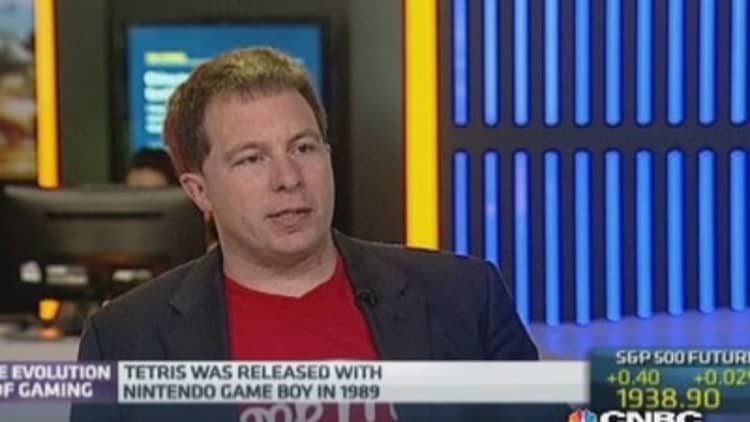Before "Halo," before "Call of Duty" and before "Grand Theft Auto," there was "Tetris."
The tile-matching game that Alexey Pajitnov created on a whim in 1984 quickly became a global sensation, going on to be played on more than 50 gaming platforms in over 185 countries.
It's a timeless success. One generation remembers it from the video game arcades. Another snaps back to playing it on their Nintendo Game Boy. But modern audience have been especially voracious players. Tetris has sold over 425 million copies on mobile devices—and Facebook's Tetris Battle game has been played more than 20 billion times.
But even the best-known icons have their secrets. CNBC.com spoke with Pajitnov and Henk Rogers, managing director of The Tetris Company, the exclusive licensor of the brand, and learned a few things that could surprise fans.
Read MoreNintendo at the crossroads
Its creator didn't see a penny until the mid-90s
In 1984, Pajitnov wrote Tetris as a program to help assess the power of a Soviet computer (the Ekectronika 60). Given the political nature of the time, publishing it himself would have been impossible, so he ceded his rights to the government for 10 years.
"Human rights were a very gray area at the time," he said. "At some point, I had to make the choice to keep fighting for my rights or to get the game published. ... I decided I am a creator, not a fighter, so I granted the rights and never complained. I think that was a very wise decision on my part."
No accidental tourist
Rogers, then the owner of Bullet Proof Software, was responsible for bringing games from around the world to Japan. And he was certain Tetris was a perfect fit for Nintendo's upcoming Game Boy system.
To get the rights, he had to fly to Moscow, where using a tourist visa he managed to get a meeting with Elektronorgtechnica (Elorg), the state-owned bureau in charge of importing and exporting software
Read More10 best-selling video games (so far) of 2014
"I wasn't supposed to talk to any Soviets, and they weren't supposed to talk to me," he said. "I certainly wasn't supposed to do any business. So when I knocked on the door, it was a big surprise to them."
He said he eventually got the meeting, which consisted of nine people, including Pajitnov and some "KGB types," who grilled him for two hours before agreeing.
Nintendo originally didn't want it
Today, Tetris and the Game Boy are inseparable in people's minds, but Nintendo originally planned to bundle a Mario game with the system, since it owned the IP. Rogers strenuously argued with Minoru Arakawa, founder and then-president of Nintendo of America, to include Tetris.
"I told him, if you want little boys to play Game Boy, pack in Mario—but if you want everyone to play Game Boy, pack in Tetris," he said.
Tetris, of course, won out—and sold over 35 million copies on the system.
Designed to make computers less intimidating
Pajitnov says he wasn't just testing the capabilities of computers with Tetris, but also was trying to show people that they had uses beyond business.
Read More New consoles don't spark retail run on game sales
"Tetris was lucky to be a messenger for early customers of the computer," he said. "It's not just a sophisticated thing to deal with numbers and spreadsheets, but also a fun toy to play a simple and engaging game. It was important for people to feel better about the computer. That was very important role for Tetris at that time."
Too boring?

Rogers loved the game from the first time he played it, but noted the beginning, tutorial levels were slow—and could bore some players.
To add excitement, he suggested to Pajitnov that bonuses be given for completing two and three lines at a time, something that became a beloved part of the game.
It's good for your health
Tetris has been included in more than 30 scientific studies over the years. A 1992 study found that playing the game helped the brain operate more efficiently. In 2008, Dr. Emily Holmes of Oxford suggested the game could help treat patients with Post Traumatic Stress Disorder. And last year, doctors at the Research Institute of the McGill University Health Centre found a variation of the game was effective at treating adult amblyopia, also known as "lazy eye."
It's in a museum
New York City's Museum of Modern Art has all sorts of curiosities, but the fully playable version of the original 1984 version of Tetris is among the most fun. The game is part of the museum's Applied Design exhibit, alongside "Pac-Man," "Myst:"and other titles.
It can make you thinner
Psychologists at Plymouth University found in February that playing Tetris for just three minutes can help reduce cravings. That makes it a fun diet aid for people trying to lose weight, as well as a useful tool for people cutting back on drinking or trying to stop smoking.
Its theme song is more than 100 years old
Tetris' theme song is a classic—literally. The music that plays during the game is a remake of "Korobeiniki," a 19th century Russian folk song.
It wasn't Pajitnov's only hit
While game site IGN in 2012 called Pajitnov "the ultimate video game one-hit wonder," he's actually been quite successful beyond Tetris. He originated and designed "Hexic," which was included with every new Xbox 360 Premium package, the first version of the console with a 20 GB hard drive.
Most recently, he developed Marbly for iOS devices.
"I'm very proud of my other [games]," he said. "And that's easy, because I try to only publish games I really enjoy myself when I'm making them."

